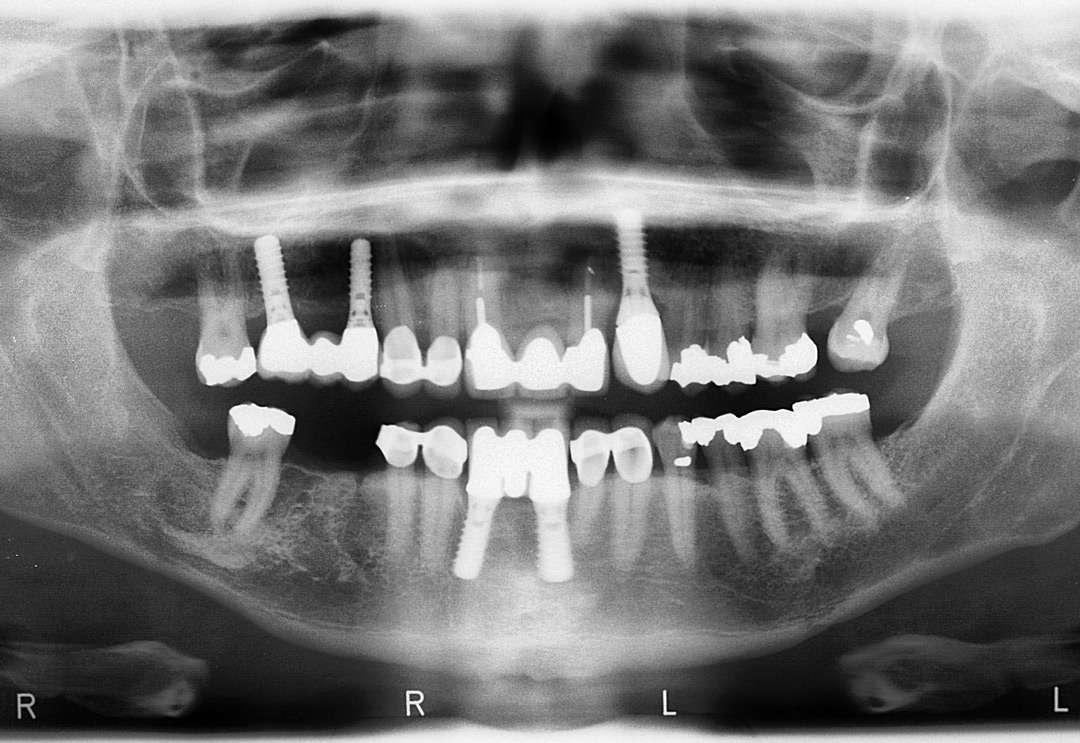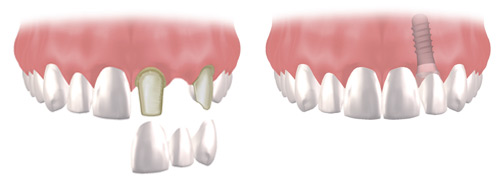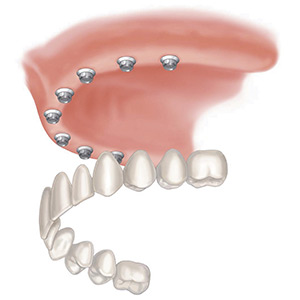Dental Implants
Give your mouth a new lease of life with dental implants

What is a Dental Implant?
A Dental Implant is an artificial root replacement to support a replacement tooth, bridge or denture in place. Dental Implants are more tooth saving than traditional bridgework, as implants don’t rely on adjacent teeth for support. They are an ideal option for people with good oral health who have lost a tooth or teeth due to an accident, gum disease or some other reason. Under proper conditions, with correct placement by a periodontist and diligent patient maintenance, implants can last a lifetime.
Advantages of Implants over Traditional Options
When a tooth is lost, it can be replaced with a partial denture, which can be removed, or a bridge which is fixed in place and cannot be removed. Implants do away with the worry of loose or painful dentures caused by rubbing on the gum, cheek or adjacent teeth as the denture moves. Implants don’t affect the quality of adjacent teeth, which would normally need to be filed down to accept crowns (bridgework) or be used as support for partial dentures. This tends to shorten the life of these teeth.

Dental Implants don’t affect the quality of adjacent teeth which would otherwise need to be filed down to support bridgework
The success rate of implants is highly predictable making them a great long-term option for tooth replacement.
Dental Implants look and feel like your own teeth, so no one will know you’ve had a tooth replaced. As they are integrated into your jaw bone, they help to maintain bone that is lost after tooth extraction, and the gum recession that often accompanies capped teeth or dentures.
What is treatment like?
Implant treatment is a team effort between your Periodontist, dentist and you. I will consult with your dentist to determine the best position and number of implants required to replace your missing tooth or teeth. The implant which looks like a screw, is placed into your jaw under local anaesthetic and allowed to heal into the surrounding bone over a period of 2 to 6 months. During this time temporary tooth replacements can be worn over the implant(s).The security of the implant is then checked and you are sent back to your dentist to make the crown (cap). This is attached to the implant by a metal post called an abutment. The crown is then usually cemented onto the abutment. After a short time you will experience restored confidence in your smile and speech.
Are you a candidate for Dental Implants?
Most people are able to consider implants if they are in good general and oral health. Adequate bone is required to surround the implant, but even people with insufficient bone can become implant candidates by using bone-grafting techniques. The best candidates are those people with healthy gums that are free of periodontal disease.

A denture can be secured by the use of implants to stop movement and increase retention. In this situation the denture can be removed by the patient for good oral hygiene around the implants
Replacing all your teeth
A denture can be secured by the use of implants to stop movement and increase retention. In this situation the denture can be removed by the patient for good oral hygiene around the implants[/caption]
If you already wear full dentures, dental implants can be used to secure your dentures and stop them moving; alleviating sore gums, speech problems and restoring confidence in day-to-day activities, which might dislodge your denture and the embarrassment that can result. Best of all those favourite foods that you gave up years ago can be enjoyed once again. In addition the bone around implants is better preserved. With conventional dentures, bone is lost as the bone that previously surrounded the tooth roots begins to resorb. This leads to recession of the jawbone and a collapsed smile.
What if there’s not enough bone for implant placement?
Sometimes in the upper jaw at the back teeth region, there is insufficient bone height to place implants because of the position of the maxillary sinuses. The sinuses are empty air spaces, with the roots of the upper teeth sometimes extending into them. When the teeth are lost, the maxillary sinus often grows in size, leaving only a thin wall of bone separating the sinus and the mouth, making it impossible to place implants.

Replacing all your teeth can also be achieved by a “fixed” solution where the crowns are screwed into the implants and can only be removed by your dentist
There is a solution and it’s called a sinus graft or a sinus lift. The sinus is entered from the side, above where the upper teeth used to be. The lining of the sinus, called the schniderian membrane is then gently lifted upward and donor bone and or a combination of graft material is inserted into the floor of the sinus. After several months of healing, the bone becomes part of the patient’s jaw and dental implants can be inserted and stabilized in this new bone.
Sometimes there is almost enough bone for implant placement and a small sinus lift can be done as the implant is being placed into the jaw. This is called the osteotome technique where the floor of the sinus is gently raised through the hole (osteotomy) that is created for the implant. Bone and or graft material is then placed into the osteotomy site before the implant is inserted. This raises the sinus membrane and new bone grows as the implant is healing into the jaw.
Where there is insufficient width of the jawbone for implant placement, a procedure called ridge augmentation can be performed.
A bone graft or bone substitute can be paced under the gum where there is a bony defect to build up the jaw and regenerate the lost bone. This is sometimes done as a separate procedure, but can often be done at the same time as implant placement. Ridge augmentation procedures can improve the appearance and the long-term success of your implant.
Dental Implants Price Guide
A more accurate cost can be discussed during your initial consultation.
Consultation
Implant Denture consults- Initial check
- Discussion with one of our periodontists
- Accurate quotation for required work
- no surgery
Complete Implant Treatment
- includes implant placement and crown fitting
- you would normally be referred back to your own dentist to complete implant treatment
Surgery
Surgery Implants- with additional implants $2,825 (each)
